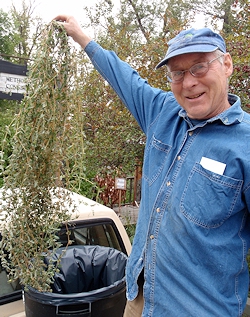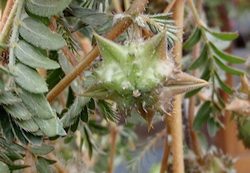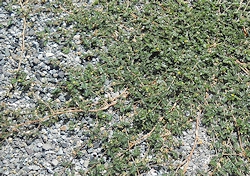Weed Guide > Puncturevine
Puncturevine / Goat Head

- Scientific Name:Tribulus terrestris
- Family: Zygophyllaceae (Caltrop or Bindii Family)
- Other Common Names: Goathead, caltrop, cat's head, devil's thorn, tackweed or sandbur
- Life-Cycle: Annual that reproduces by seed but can cover long distances attached to vehicles and animals.
- Toxicity: Can be toxic to livestock (especially sheep) if eaten in large quantities, and can injure the mouth and digestive tract or feet of animals.
| Description | Bloom (varies by elevation) |
What to Do | When? | Invades Undisturbed Land | State Class |
|---|---|---|---|---|---|
| Grows low to the ground and spreads out from a central point like a flat mat. Tiny, hairy, finely-divided leaflets grow opposite each other on stem. Mat can grow up to several feet in diameter. | Yellow flowers up to 1/2 inch wide with five petals. Blooms continually from late spring through early fall. | Hand-pull or hoe seedlings and small patches in spring and late fall if there are no seeds present; bag plants with seeds; thick mulch or black plastic deters new growth. | Early spring before it blooms and produces seeds. | Not typically. Found in disturbed open areas such as roadsides, building lots, rangeland and agricultural fields. | B |

General Description
- Puncturevine is an annual weed that sprouts and grows from seed every year and then dies.
- Starting from the central sprouting point at the root, stems spread out radially, staying low to the ground when the plant has direct sunlight. Dense mats can form with leaf-covered stems trailing out like runners, except the plant does not send roots from these stems. Mats start small and can grow quite large to several feet in diameter. In the shade, the same thing happens but the stems can grow slightly upright instead of flat to the ground.
- The leaves are abundant, growing all over the stems from base to tip. Leaves are "pinnately compound," meaning they are finely-divided with opposite-paired leaflets. The leaflets are tiny with fine hairs.
- Small yellow flowers up to 1/2 inch wide with five petals bloom from late spring to early fall.
- The seedpods start out green and form a cluster of round spiny burrs. As they mature, they turn gray or tan and break apart into individual burrs. These burrs are very hard with one or two sharp tack-like spikes that can adhere to bike and car tires, shoes and clothing, and the fur, feathers, or feet of animals.
- Puncturevine is native to southern Europe but now scattered across North America primarily in disturbed areas such as roadsides, cultivated fields, and horse and livestock corrals. puncturevine is easily dispersed on animals, and bicycle and car tires, and it has managed to make its way to many areas of the Methow though it is still relatively uncommon and manageable if found early.
Life-Cycle
- As an annual weed, puncturevine sprouts and grows from seed every year. At the onset of winter, plants die but the seeds that remain start new plants.
- Puncturevine has a single, woody taproot.
- The plant may start flowering within 3 weeks of germination and flowers can bloom continuously from late April to October.
- After pollination, a green seedpod forms. The pod is an odd-shaped cluster with numerous sharp spikes. As the seedpod matures, it turns tan or gray, gets very hard, and breaks apart into individual round "heads" with usually two small spiny thorns, resembling a goat's head with two horns.
- Seed germination requires good soil moisture and warm temperatures, but after the plant is established it can tolerate dry soils due to its fast-growing deep taproot.
- Seeds may remain dormant and viable in the soil for up to five years, choosing to germinate when the conditions are favorable.
- puncturevine plants cannot tolerate freezing temperatures and die by late fall.

Prevention & Control
Prevent
- Keep land disturbance to a minimum. puncturevine typically does not invade undisturbed land.
- Refrain from driving vehicles and machinery through infested areas.
- Animals, vehicles and machinery can unwittingly transport seeds and disperse seeds over large areas - check your tires, equipment, and animals before leaving areas where puncturevine may be present.
- It's critical to remove plants before they produce seeds.
Hand Pull & Hoe
- Hand-pull or hoe new plants early before they go to seed.
- Hand-pulling, hoeing or digging is a very good option for young plants and small populations. The single taproot is easily severed or pulled out, especially early in the spring or if new plants come up in the fall, or if the plant is in gravel. Hoeing or pulling should be done before the plant has flowered and produced seeds. If seeds are present, be extra careful to scan the soil and pick up any seeds that may have come off plants.
Mowing, Mulching & Cultivation
- Puncturevine is best controlled by hand removal or by hoeing to cut the plant off at its taproot.
- Shallow tilling (about 1 inch deep) of seedlings or small plants can be effective in larger areas.
- Deeper tilling is not recommended as this can bury seeds, giving them the chance to germinate for several years afterwards.
- Like hoeing or pulling, cultivation should be initiated before flowering and seed production.
- Mulches can be a good way to control puncturevine. Organic mulches should be at least 3 inches thick to be effective. However, puncturevine burrs that fall on top of mulch surfaces can establish on the mulch surface since the taproot is so deep. Synthetic mulches, which screen out light and create a physical barrier to seedling development, also work well.
- Aeration of compacted sites and planting competitive desirable plants can also reduce the impact of puncturevine by making the area more favorable for the growth of the desired plants and reducing resources available to the weed.
- Mowing is not an effective method of control since the plant grows so low to the ground.
Biological Control
- A seed weevil (Microlarinus lareynii) and a stem weevil (M. lypriformis), both native to India, France, and Italy, were introduced into the United States as biocontrol agents in 1961. Used together they have been found to effectively control large populations of puncturevine in the southwestern United State. Attempts to introduce the weevils in Oregon, Washington and Idaho have generally failed (the weevils did not establish themselves and perhaps didn't survive over the winter), though both weevils do appear to be doing well in the Umatilla-Hermiston area of Oregon. Microlarinus lareynii lays its eggs in the immature burr or flower bud and the larvae feed on and destroy the seeds. Microlarinus lypriformis is a stem weevil that lays its eggs in the undersides of stems, branches, and the root crown, and then tunnels into the stem. Although the stem weevil is slightly more effective than the seed weevil, the weevils are most effective if used together and the puncturevine is moisture-stressed.
- Both species of weevils are available for purchase from biological control suppliers but the weevils are unlikely to survive our winters. We have not heard of anyone in the Methow using them. Contact the Okanogan County Weed Board or the WSU Integrated Weed Control Project for more information on the weevils.
See the whole “Toolbox of Weed Control Methods” for more details.
Interesting Tidbits
- A typical puncturevine plant will produce 200 to 5,000 seeds during one growing season
- The plant can be used as a herbal remedy for a wide variety of conditions from kidney and urinary problems to high blood pressure, angina, high cholesterol, and anemia.
- Moreover, medicinally, the plant is most widely used to boost levels of testosterone, enhance sexual desire in both men and women, and to treat erectile dysfunction in men. It has a long history of use in traditional Chinese medicine and Indian Ayurvedic practice, and more recently as a supplement for high-level athletes (as a supplement it is known as Tribulus). But, don’t go planting puncturevine for this purpose - remember, it is a Class B noxious weed!